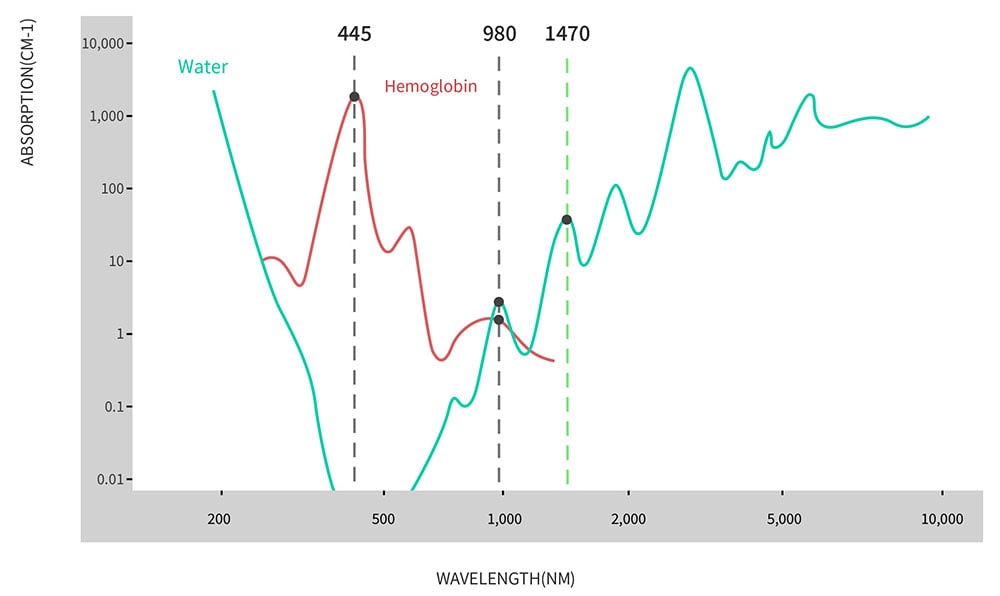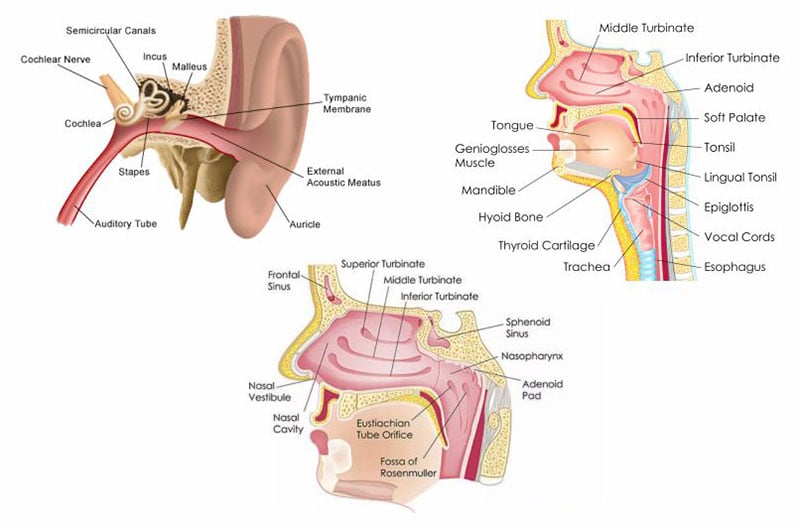Minimally Invasive ENT Laser Treatment
Laser is now universally accepted as the most advanced technological tool in various surgery specialties. However, the properties of all lasers are not alike and surgeries in the ENT field have advanced significantly with the introduction of Diode Laser. It offers the most bloodless surgery available today. This laser is especially suited for ENT works and finds application in various aspects of surgery in the ear, nose, larynx, neck, etc. With the introduction of diode ENT Laser, there has been a significant improvement in the quality of ENT surgery.
445nm 980nm 1470nm Wavelength in ENT Laser
The wavelength of 980nm has a good absorbance in water and hemoglobin, 1470nm has a higher absorbance in water, and 445nm has a higher absorbance in hemoglobin.
Compared to the CO2 laser, our diode laser exhibits significantly better hemostasis and prevents bleeding during the operation, even in hemorrhagic structures such as nasal polyps and hemangioma. With the DlMED ENT laser system precise excisions, incisions, and vaporization of hyperplastic and tumorous tissue can be performed effectively with almost no side effects.
Otology
With its extremely thin laser fiber (core diameter: 400 μm), our laser system can be used safely and very precisely on delicate structures in the inner ear using the contact method. In contrast to the CO2 laser using the open beam method, this method almost completely eliminates the risk of laser energy inadvertently affecting other areas.
The laser energy is only applied upon laser contact with the target tissue and in very short impulses, resulting in the absorption of all of the laser energy immediately at the tip of the fiber. The thermal damage depth is thus at a minimum.
Laser paracentesis is a minimally invasive bloodless operation that has the advantage of the opening in the eardrum made by the laser remaining open for about 3 weeks. The healing process is much shorter.
Endoscopic Nasal Surgery
Endoscopic surgery is an established, modern process in the treatment of nasal and paranasal sinuses. However, due to the strong bleeding tendency of the mucosal tissue surgical treatment in this area is often challenging. A poor operating field of vision due to bleeding often results in imprecise work; prolonged nasal packing and significant patient and doctor effort are usually unavoidable.
The main imperative in endonasal surgery is to maintain the surrounding mucosal tissue as much as possible. Due to the ideal laser-tissue interaction of wavelength 445 / 980 / 1470 nm, adjacent tissue is protected optimally. This leads to rapid reepithelialization of bone areas that had been opened up. As a result of the good hemostatic effect, precise procedures can be undertaken with a clear view of the operating area. Using the fine and flexible 400umoptical laser fibers, optimal access to all nasal areas is guaranteed.
Oropharynx
One of the most frequent operations in the oropharynx area is laser tonsillotomy in children (Kissing Tonsils). In pediatric symptomatic tonsillar hyperplasias, LTT represents a sensible, gentle, and very low-risk alternative to tonsillectomy (children up to 8 years of age). The risk of postoperative bleeding is minimal.
The minimal amount of post-operative pain thanks to the shortened period of healing, convenient operations, and the leaving behind of tonsillar parenchyma are significant advantages of laser tonsillotomy.
Larynx
The main imperative in the main surgical treatments in the larynx area is to avoid significant scar formation and undesired tissue loss since this can significantly affect phonetic functions.
The pulsed diode laser application mode is used here. This way, the thermal penetration depth can be further reduced; tissue vaporization and tissue resection can be executed precisely and in a controlled manner, even on sensitive structures, while optimally protecting the surrounding tissue.
Clinical Applications of ENT Laser Treatment
Diode lasers have been used in a wide range of ENT procedures since the 1990s. Today, the versatility of the device is limited only by the knowledge and skill of the user. Thanks to the experience built up by clinicians over the intervening years, the range of applications has expanded beyond the scope of this document but includes:
Clinical Advantages of ENT Laser Treatment
- Precise incision, excision, and vaporization under an endoscope
- Almost no bleeding, better hemostasis
- Clear surgical vision
- Minimal thermal damage for excellent tissue margins
- Fewer side effects, minimal healthy tissue loss
- The smallest postoperative tissue swelling
- Some surgeries can be performed under local anesthesia in outpatient
- Short recovery period



